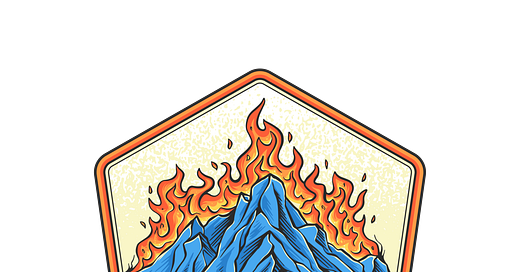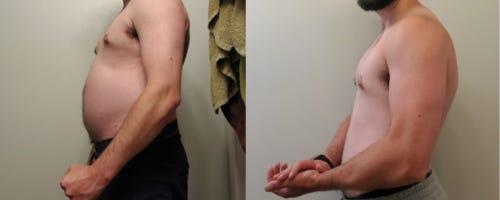Happy Thursday, and welcome to the 22nd edition of the Thrive Protocol Letter.
Today at a glance:
A thorough blueprint into exactly how I’d go from being “skinny fat” to lean and muscular
“Winning has no finish line. It’s about the responsibility to ourselves to take control of what little things you can in this world regardless of circumstance, to train your mind to switch your perspective and focus on being the absolute best you can be in the areas you do have control over.” - Chris Bumstead
Skinny fat is a term that describes the majority of men these days:
Their BMI is in the normal range (maybe slightly high), but they have more body fat and less muscle than they’d like.
Skinnyfat men typically store their fat around their belly — they can usually hide it pretty well with a loose-fitting shirt, but when the shirt comes up, a pretty serious belly is exposed.
Skinnyfat guys sometimes wonder what the best solution is:
Should they bulk?
Should they cut?
It can be extra confusing because these guys feel like they’re doing the right thing most of the time: I’ve talked to many skinny fat guys who are actively exercising, lifting, and doing their best to eat a healthy diet.
If I woke up tomorrow as a skinny fat man (178 lbs, 5’10, 22% body fat) —
This is the roadmap I’d use.
A moderate calorie deficit
In some cases, going on a gaining phase may be appropriate for a skinny fat man.
This could be if he is so small that a calorie deficit would involve such a meagre amount of calories that it would be brutal.
But in the vast majority of cases, step 1 is always to get lean first.
But because of the “skinny” fat part of the equation, he’ll also want to build muscle.
Good news: most skinny fat men can get leaner and build some muscle at the same time.
Whether or not this is possible for everyone (seasoned lifters who are relatively lean) is one of the most hotly debated topics in fitness.
What isn’t debated, however, is whether a newbie who hasn’t made great gains and is over 20% body fat can gain muscle and lose fat at the same time.
This type of person can always pull it off.
And if you’re skinny fat, you fall into this camp, even if you’ve been going to the gym for a few years.
The best way to recomp your body (gain muscle while losing body fat) is to use a moderate calorie deficit.
Go too extreme, and you won’t have the recovery capacity to build muscle.
A 500-calorie deficit is the highest this should be, and it could be a bit smaller.
Step 1: I’d get a sense of my maintenance level calories; then I’d start by aiming to eat fewer calories than this by 300 - 500.
4x protein meals per day
While the importance of eating protein super frequently (think the 8-small meal per day habit of bodybuilders) has been reduced now that we know more than 30 grams of protein can be absorbed, it is still ideal for someone who wants to maximize muscle growth to get several protein feedings per day.
Protein Myth Busting + Should you do Supersets?
Today at a glance: Debunking 2 of the most common myths about protein consumption Exploring the pros and cons of using supersets to make your workouts more efficient.
4 is a good number to shoot for.
It’s a balance between being achievable and realistic. It’s frequent without seeming like you’re eating constantly.
4 meals per day is what I like to do.
Each of these 4 meals must have protein — at the very least 30 grams and ideally 40+ grams.
4 x 40-gram protein servings is an easy way to remember it.
Inadequate protein is possibly the #1 contributor to the skinny fat look, so this part isn’t trivial.
Step 2: I’d be non-negotiable about hitting my bodyweight in grams of protein, spread over 4 meals per day, every day.
I’d Stop Running
I love running.
It’s an amazing sport.
But running should be reserved for those pursuing improvement at the sport — it’s not for improving body composition.
You can’t improve at multiple fitness adaptations very well when you train them at the same time, and this is especially true for fitness adaptations that differ significantly (like hypertrophy and endurance).
Don’t get confused — the jacked hybrid athletes you see all over social media are the result of years of intelligent periodization.
In most cases, they built muscle first from years of focused resistance training and then switched over to running (while still lifting enough not to lose any muscle).
One does not simply go from skinny fat to Nick Bare in a year with a hybrid athlete program.
The takeaway is that if you’re skinny fat and you would desperately like to be lean and muscular, you want to allocate 100% of your adaptive capacity to one fitness adaptation, and that adaptation is hypertrophy (increasing the size of muscle fibres).
This means that you would ideally stop running or going for long bike rides if you do them.
You want your cardio to be 80-90% low impact: Walking, the elliptical machine, and the incline treadmill (4mph at a 12-degree incline).
The other 10-15% should be short bursts of high-intensity cardio, either sprints or stationary bike sprints.
Important note: response to HIIT varies drastically from person to person.
Some people find that the juice isn’t worth the squeeze, especially in a fat-loss phase. They end up more fatigued and extra hungry, and some of these exercises reduce the chances of injury.
The main focus is just being active and having a high step count; high-intensity cardio is potential icing on the cake and not necessary.
Step 3: I’d stop running, get 12-15k steps per day and use low-impact cardio to make that happen.
I’d follow a Hypertrophy program
It took me 4 points to get to the obvious point of lifting weights.
But simply “lifting weights” would be a too-low-resolution way to put it.
Specifically, I’d follow a hypertrophy program.
To emphasize this point, I’ll introduce you to a friend.
I’d like you to meet my first-ever client, Ian.
Ian is a friend from my days as a musician. While he, too, transitioned out of music full-time, Ian is a great saxophonist.
We used to work the casino circuit together in a cover band, and I have fond memories of the two of us eagerly attacking the free buffet when we would play holiday parties.
I helped Ian lose about 30 pounds over a few months while adding some muscle and getting much stronger.
Here’s the point: Ian had been going to the gym 3 x per week for months leading up to the start of us working together (and that before picture).
He’d just been following the wrong program for his goals.
Ian was doing the 5x5 program, a common strength program designed by world-famous strength coach Mark Rippetoe.
While it’s a fantastic approach to building strength, it’s not ideal for hypertrophy.
A program aimed at maximizing muscle fibre size will have some significant differences:
Higher rep ranges (5 - 12)
Closer proximity to failure
More use of machines
More use of isolation and auxiliary exercises
Intensity techniques (drop sets, giant sets)
I took Ian from 5x5 to doing a power-building program that still involved some low-rep training on compound lifts but followed that with higher-rep hypertrophy-focused training + some intensity techniques.
Ian’s strength continued to improve while he successfully recomped (rather than spinning his tires with 5 x 5).
The point of Ian’s story is that it’s not just about “going to the gym” but about what you do there.
Following a strength-specific program will not get you the best results for improving your body composition and leaving behind the skinny fat lifestyle.
Nor will Crossfit or the high-intensity fitness classes that have become so popular (Orange Theory).
You’ll get the best results from training like a bodybuilder (just skip the peds and body oil).
Step 4: I’d follow a program geared toward hypertrophy, so it would include sets in the 5-12 range, close proximity to failure on all lifts, a wide range of exercise selection (including isolated lifts), and some intensity techniques like drop sets and giant sets.
I’d Stop Exercising and Start Training
90% of people I see in commercial gyms are exercising.
They’re going through the motions, getting a good sweat in. This is better than sitting on the couch, but it’s not how you progress.
You want to switch your thinking from exercising to training.
When you train, you’re specifically seeking improvement in a fitness adaptation. You’re pushing yourself, tracking your progress, and implementing progressive overload.
Even with the right program and 4 servings of protein per day, you won’t see a substantial difference until you stop these common mistakes:
Weak effort
You don’t build muscle from doing sets with 5 reps left in the tank. Every set should be taken to failure or within 1-3 reps of it at most.
Ego lifting
Ego lifting manifests in several different ways, such as small ranges of motion, using momentum to move the weight, lifting too fast, or contorting your body to move the weight. Lift a load you can handle and lift it properly.
Tracking what you do
You need to be beating the logbook over time. Track the lifts you do and how they feel, and set out to improve them every session.
What gets measured gets managed.
Step 5: I’d start taking the gym seriously by training hard, using proper technique, and keeping track of my progress over time.
I’d Ditch Alcohol
Controversial one here, and I’ll probably lose a few of you at this point.
But alcohol is unambiguously toxic for any health and performance goals.
It is irredeemably bad for you; it is a source of empty calories (significant calories if you enjoy beer), it encourages the uninhibited consumption of more calories from food, it ruins your sleep, it destroys your gut health, it impedes muscle growth, it increases your heart rate and blood pressure, increases the risk of cancer, and — well we’d be here all day if I wanted to seriously outline how bad alcohol is.
A common trait of skinny fat guys is that they like to drink. Beer in particular.
It is possible to lose fat and get in shape while drinking moderately, but there needs to be a huge emphasis on the “moderate.”
For many of you, this may be the missing piece.
I’d strongly encourage you to commit to abstaining from alcohol for something substantial enough to truly see the difference.
None of these light-weight 30-day challenges like Dry January or Sober October.
Do 100 days.
Go 100 days without alcohol, and then tell me if you don’t see a drastic positive change to your health, well-being, and physique.
If I woke up skinny fat tomorrow, I’d
Implement a moderate calorie deficit
Eat 4 high protein meals per day
Stop running and focus on low-impact cardio
Follow a hypertrophy-focused resistance training program
Start training with intensity and tracking my progress
Stop drinking alcohol
Content I’m Enjoying:
I’m currently reading Turning Pro by Steven Pressfield.
Steven Pressfield is most famous for The War of Art; and his concept of Resistance as the complete suite of self-sabotaging behaviours that prevent us from creating art, businesses, or making any positive change in our lives.
If you’ve been procrastinating on anything important, Turning Pro may be the existential kick in the ass you need.
This is a fantastic interview with Peter Attia on modern wisdom. Full of actionable insights on physical and mental health optimization
Hope you found that useful!
Best of luck with your training, goals, and everything else.
See you next week -
Colin






